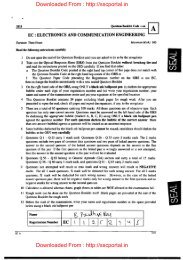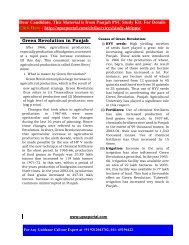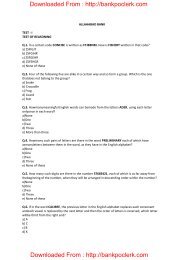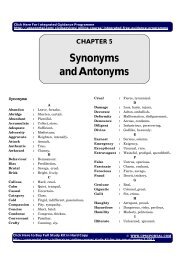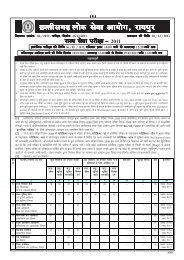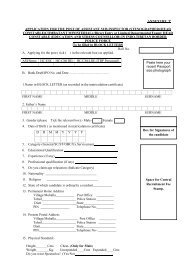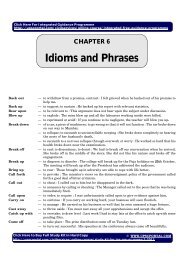Punjabiat and Punjabi Language Dear Candidate, This ... - upscportal
Punjabiat and Punjabi Language Dear Candidate, This ... - upscportal
Punjabiat and Punjabi Language Dear Candidate, This ... - upscportal
- No tags were found...
You also want an ePaper? Increase the reach of your titles
YUMPU automatically turns print PDFs into web optimized ePapers that Google loves.
<strong>Dear</strong> C<strong>and</strong>idate, <strong>This</strong> Material is from Punjab PSC Study Kit. For DetailsClick Here : http://<strong>upscportal</strong>.com/civilservices/study-kit/ppsc172 Integrated Study Kit for PPSC<strong><strong>Punjabi</strong>at</strong> <strong>and</strong> <strong>Punjabi</strong><strong>Language</strong><strong><strong>Punjabi</strong>at</strong> means a spirit of feeling proudto be a <strong>Punjabi</strong> i.e. all the people in Punjabshould nurse a feeling of mutual solidarity.<strong><strong>Punjabi</strong>at</strong> also means that <strong>Punjabi</strong>s shouldfeel themselves one by rising above barrierslike religion, colour, ethnicity, caste etc. Theirhearts should beat together. They should takeinterest in the development of Punjab <strong>and</strong>gird up their loins to take their state aheadof other states. <strong>Punjabi</strong> language has a greatrole to play in establishing <strong><strong>Punjabi</strong>at</strong>. <strong>Punjabi</strong>language did not come into existence all of asudden. Its development is integrally relatedwith the development of <strong><strong>Punjabi</strong>at</strong>. Here weare discussing this aspect as under:<strong><strong>Punjabi</strong>at</strong> <strong>and</strong> <strong>Punjabi</strong> Culture:<strong><strong>Punjabi</strong>at</strong> <strong>and</strong> <strong>Punjabi</strong> culture are just liketwo sides of the same coin. Delineating themutual link between the two Dr. DhanwantKaur has said that the concept of <strong><strong>Punjabi</strong>at</strong>is inalienable from the <strong>Punjabi</strong> culture <strong>and</strong>often we take them synonymously also. Tomy mind there is no difference between thetwo but it would be proper to distinguishbetween the meaning <strong>and</strong> concept of both.<strong>Punjabi</strong> culture is a vast multi-layer systemwhile <strong><strong>Punjabi</strong>at</strong> is the psyche built on these.When we use the concept of <strong>Punjabi</strong> culture,it implies <strong>Punjabi</strong> behaviour, thought pattern,family etc. It also includes those culturalinstitutions on which <strong>Punjabi</strong> culture is built.But when we conceptualise <strong><strong>Punjabi</strong>at</strong> we donot tend towards these institutions but mean<strong>Punjabi</strong> personality, temperament <strong>and</strong> way ofthinking which provides it a unique identity.www.<strong>upscportal</strong>.comBy <strong><strong>Punjabi</strong>at</strong> we mean <strong>Punjabi</strong> physique <strong>and</strong>the spirit - Physique built up by the temptingclimate of Punjab, Physique which has foiledthe sinister designs of the invaders.Three Aspects of Culture: According toDr. Roshan Lai Ahuja, culture is synonymouswith 'Sanskriti' in Sanskrit. It has threeaspects -Physical, Social <strong>and</strong> Artistic.Physical aspect pertains to the means oflife or matter e.g. eating, drinking, dressing,residing. The cultural aspect belongs to theway of life formed by geographical <strong>and</strong> climaticconditions. Physical aspect may include thefeatures, stature, bony structure, esh <strong>and</strong>the warmth of blood. These elements arephysical <strong>and</strong> natural only having nothingto do with the feelings <strong>and</strong> beliefs. Natureis absolute <strong>and</strong> its product is also absolute.In other words, the question of absoluteness<strong>and</strong> relativity does not arise in the physicalaspect of nature. Second aspect of culture issocial which is a product of man's strugglefor survival against nature. Man is a productof nature no doubt, but is quite fragile incomparison to the forces of nature <strong>and</strong> isunable to maintain his existence. He has todepend on others. Therefore he has to keepgood relations with others. <strong>This</strong> is called coexistence.The co-existence is absolute. Theartistic aspect of culture includes literature,folk arts <strong>and</strong> language.Dr. Baldev Raj Gupta while dening themutual relation of language <strong>and</strong> culturesays that through language man expresseshimself <strong>and</strong> through culture man perpetuateshis tradition, The common link betweenlanguage <strong>and</strong> culture is 'idea'. Throughlanguage man lays bare his heart <strong>and</strong> shareshis grief with others, while through culturalrites <strong>and</strong> rituals, he propitiates the spirits ofhis ancestors <strong>and</strong> marries off his young sons<strong>and</strong> daughters. So language <strong>and</strong> culture,For Any Guidance Call our Expert at +91 9212043702, 011- 65196422
<strong>Dear</strong> C<strong>and</strong>idate, <strong>This</strong> Material is from Punjab PSC Study Kit. For DetailsClick Here : http://<strong>upscportal</strong>.com/civilservices/study-kit/ppsc172 PanjabIntegrated Study Kit for PPSC 173both are means of communicating humanthoughts.The Elements of <strong>Punjabi</strong> Culture <strong>and</strong><strong><strong>Punjabi</strong>at</strong>- There are many elements in<strong>Punjabi</strong> culture which lend <strong><strong>Punjabi</strong>at</strong> to it.Common thinking comes at number oneamong these. All the people of Punjab make ajoint endeavour for the development of Punjab.The folk-music of Punjab also enkindles afelling of <strong><strong>Punjabi</strong>at</strong> in the people. Accordingto Dr. Sohinder Singh Bedi, <strong>Punjabi</strong>s havegot music by birth. Immediately after birth,sweet notes of music <strong>and</strong> beats of a Dholakpour into the ears of the child. Folk-musicbecomes one with the soul of the new bornbaby <strong>and</strong> lives with him throughout his life.The folk-art of Punjab also has a role to playin cultivating <strong><strong>Punjabi</strong>at</strong>. In this connectionthe above writer says that the folk art ofPunjab is as old as its culture The oldestspecimens of the folk art of Punjab have beenfound from the excavations of Harappa <strong>and</strong>Ropar. These include some earthen pitchers<strong>and</strong> terra cottas which were used to -decoratethe houses. In painting, hill-art has reignedsupreme. Similar way of life has also createda sense of <strong><strong>Punjabi</strong>at</strong>.<strong>Language</strong> Aspect- <strong>Language</strong> aspect hasalso contributed a lot in creating <strong><strong>Punjabi</strong>at</strong>.<strong>Language</strong> by itself is a part of culture. <strong>Punjabi</strong>language did not come into existence all of asudden. It has emerged from already existentlanguage in this region. A general view isthat it owes its origin to Shaurseni but somelinguists nd its origin in Kaikaye which wasspoken in Multan region. Whichever view maybe right but orie thing is clear that <strong>Punjabi</strong>language had its origin in Apbhransh whichwas already spoken here. <strong>Punjabi</strong> languageis the language of common man. It does notbelong to any particular community, caste orreligion, it belongs to all punjabis. Its role increating <strong><strong>Punjabi</strong>at</strong> has always been relevant<strong>and</strong> substantial. The <strong>Punjabi</strong> language foundits maiden expression in the poetry of Naths<strong>and</strong> Jogis in protest against Brahminism. Thelanguage of the Brahmins was Sanskrit butits opposition required a folk language now.Therefore, Naths <strong>and</strong> Jogis made <strong>Punjabi</strong> amedium of their expression. Written throughthe medium of language, this literature iscomplete in itself <strong>and</strong> is symbolic of <strong><strong>Punjabi</strong>at</strong>.Gorakhbani says:www.<strong>upscportal</strong>.comJo Ghar Tyag Kahave JogiGhar vasi ko kahe jo BhogiParam Tatt Ke Hoi Na MarmiKahe Gorakh so Maha Adharmi,(He who calls himself a recluse byrenouncing his house <strong>and</strong> calls householderan enjoyer, is ignorant of the ultimate Truth.Nobody can be a bigger indel than him).Thereafter, <strong>Punjabi</strong> language absorbedmany words of Arabic <strong>and</strong> Persian due to theimpact of Muslims.Baba Farid's <strong>Language</strong>: A study of BabaFarid's Shalokas reveals that he expressedSu feelings through <strong>Punjabi</strong> languagewith an admixture of Lehndi. His Shalokasinspired people to remember the name of God<strong>and</strong> stressed righteousness. These shalokaswere meant not for a single caste or creed butfor all <strong>Punjabi</strong>s. He urged the people to riseabove petty considerations <strong>and</strong> live togetherpeacefully. Although he has used <strong>Punjabi</strong>language in his shalokas, but the reectionof Lehndi dialect can be vividly seen on his<strong>Punjabi</strong>.Gurbani has a mass appeal: The Bani(Divine Poetry) of all the Gurus creates a spiritof oneness in the hearts of people. Gurbaniprohibits casteism <strong>and</strong> untouchability. Itexhorts people to partake langar (CommonKitchen) in a queue. Thus, Gurbani bringsFor Any Guidance Call our Expert at +91 9212043702, 011- 65196422
<strong>Dear</strong> C<strong>and</strong>idate, <strong>This</strong> Material is from Punjab PSC Study Kit. For DetailsClick Here : http://<strong>upscportal</strong>.com/civilservices/study-kit/ppsc172 174 Integrated Study Kit for PPSCpeople together with a spiritual string of unity.About Guru Granth Sahib, Dr. Jeet SinghSital writes that Guru Granth Sahib is theonly great religious scripture which spreadsmessage for all <strong>and</strong> makes no discriminationon the basis of caste, creed, religion, colour,ethnicity, nationality etc. He adds that 'GuruGranth Sahib' is a multilingual scripturewhich enshrines the contours of the dialectsspoken by the masses at that time.Later Writers: After this period, therewere some poets <strong>and</strong> writers during RanjitSingh's period also who expressed theirpassion for <strong><strong>Punjabi</strong>at</strong> by writing literature in<strong>Punjabi</strong> language. <strong><strong>Punjabi</strong>at</strong> is reected wellin 'Jangnama' of Shah Mohammed. The wayProf. Puran Singh has expressed <strong><strong>Punjabi</strong>at</strong>in his poetry, is unparalled. Even nowmany new writers <strong>and</strong> poets have expressed<strong><strong>Punjabi</strong>at</strong> in their writings.The Tragedy of <strong><strong>Punjabi</strong>at</strong>: In modemage, the tragedy of <strong><strong>Punjabi</strong>at</strong> is that it is beingdiscussed in a negative way. <strong>Punjabi</strong>s do nothave a feeling of being <strong>Punjabi</strong> because ofa common nationality; they have been giventhis feeling by others as a minority outsidePunjab. The <strong>Punjabi</strong>'s is the western <strong>Punjabi</strong>n Pakistan also suffer from this minoritysyndrome. Dr. Attar Singh attributes thissituation to the narrow thinking of Hindus<strong>and</strong> Sikhs of East Punjab cannot transcendtheir contradictions despite their commontraditions, how can the <strong>Punjabi</strong>s of WestPunjab foster a sense of <strong><strong>Punjabi</strong>at</strong> in the faceof religious differences.The Role of <strong>Punjabi</strong> <strong>Language</strong>- <strong>Punjabi</strong>language can play a vital role in establishing<strong>and</strong> strengthening <strong><strong>Punjabi</strong>at</strong>. Hindus <strong>and</strong>Sikhs of East Punjab <strong>and</strong> Muslims of WestPunjab may be having their own mutualreligious differences, yet <strong>Punjabi</strong> is the onlylink between them. <strong>Punjabi</strong> is spoken <strong>and</strong>taught in both the Punjabs. Literature iswww.<strong>upscportal</strong>.comalso written in it; but the needs of day is toliberate it from the political boundaries. Inthis connection Dr. Attar Singh offers somesuggestions:(a) Making <strong>Punjabi</strong> language the basis of<strong><strong>Punjabi</strong>at</strong> is not sufcient in itself. Itshould be transformed in such a wayas become a symbol of <strong><strong>Punjabi</strong>at</strong> intotality.(b) To cultivate love for <strong>Punjabi</strong> language inall the castes, creeds, communities <strong>and</strong>classes of Punjab, <strong>Punjabi</strong> languageshould relfect the culture of all of them.Their scriptures, history <strong>and</strong> biographiesshould be translated into <strong>Punjabi</strong>.(c) Entire cultural heritage of Punjabshould be acknowledged as <strong>Punjabi</strong>.Irrespective of its origin in any otherlanguage, it should be translated into<strong>Punjabi</strong> Part A- Punjab 193 so that theaccumulated intellectual <strong>and</strong> spiritualexperience of <strong>Punjabi</strong>s should exp<strong>and</strong>its boundaries.(d) The self-esteem of <strong>Punjabi</strong>s should bepromoted by preparing history of thevarious aspects of <strong>Punjabi</strong> culture, folklore,literature <strong>and</strong> ideas. Conclusion-To sum up we can say that <strong>Punjabi</strong>language <strong>and</strong> <strong><strong>Punjabi</strong>at</strong> are closelyrelated to each other. <strong>Punjabi</strong> doesnot mean today what.it should meannecessarily. Religious bigotry <strong>and</strong>politics are coming in its way. In thiscontext, <strong>Punjabi</strong> language can play aconstructive role The suggestions givenby Dr. Attar Singh in this connectionare veil valuable.For Any Guidance Call our Expert at +91 9212043702, 011- 65196422




